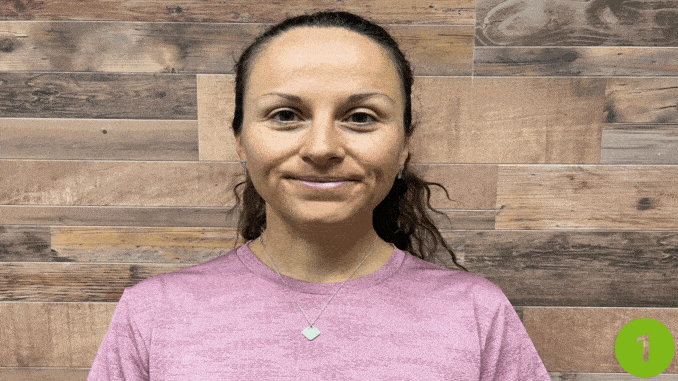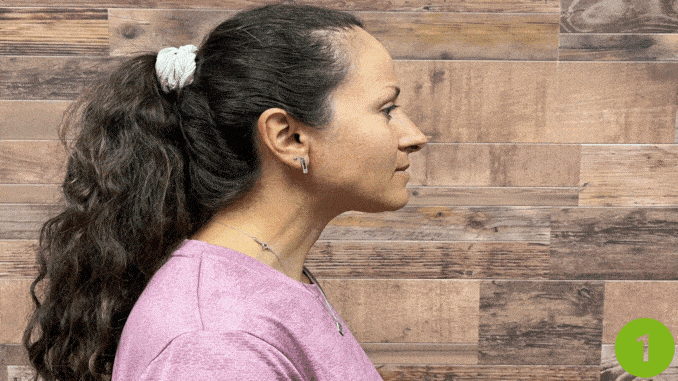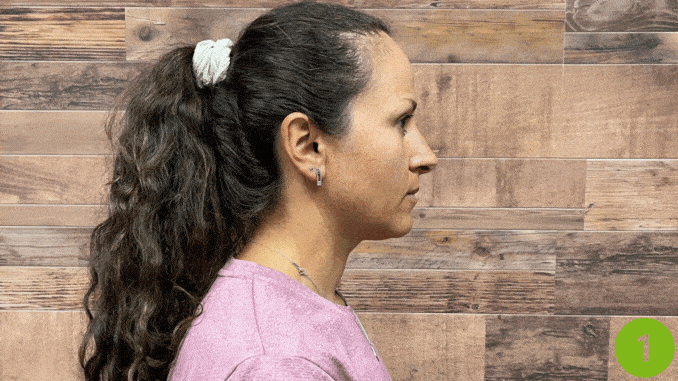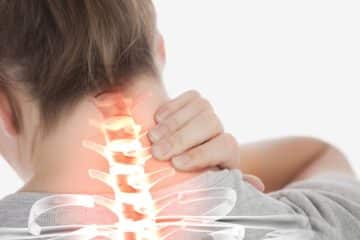Neck pain [1] can sneak into your day—tightness when you wake up, stiffness after work, or that dull ache that never fades. But lasting relief is closer than you think. If you’ve been searching for how to relieve neck pain, you’re in the right place.
We’re preparing something that will help you move freely, feel stronger, and finally leave neck pain behind. While you wait, explore this blog for expert tips and simple exercises to start feeling better today—because something powerful is coming soon.
Typically neck pain will be predominately centered in either the front or the back of the neck. Depending on where your pain is focused, there are actions you can take to minimize the stress on this all-important muscle group.

Pain in The Front of the Neck
When you are experiencing pain along the front of your neck, it is usually due to stress placed on the sternocleidomastoid muscle. The sternocleidomastoid is the largest muscle in the front of the neck, and extends from just under your ear and jaw, down to your collarbone. Pain in this area can be due to several different reasons.
1. Tension
Everyone naturally holds tension in different areas of their body. Being aware of where you tend to tense up can help you actively take the necessary steps to decrease tension in that area. If you are someone who is more prone to neck tension, there are things you can do to naturally reduce the stress you are holding in your neck area.
Learning some relaxing, deep breathing techniques can help, as does maintaining good posture. Regular exercise is also a great way to reduce tension throughout your body and support how to relieve neck pain effectively.
2. Sleep Posture
As mentioned previously, waking up with a stiff and sore neck is not uncommon. But why does this happen? Give some thought to your sleep posture and how it is impacting your neck alignment.
Look at your pillow and think about the position it is putting your neck in throughout the night. If you travel often, consider bringing your own pillow to ensure a good night’s sleep. Small adjustments like these are part of learning how to relieve neck pain during rest.

3. Your Teeth
Grinding or clenching your teeth at night can create tension throughout your jaw and neck, so definitely consider this if you are often waking up with neck pain. Ask your partner if you are grinding at night or ask your Dentist to analyze your wear pattern at your next appointment. You might want to invest in a night appliance to decrease the pressure on your teeth and jaw when you are sleeping.
4. Review Your ‘Mat’ Work
When you are exercising on the floor, consider any stress you are putting on your neck during any abdominal or forward flexion exercises. Exercises like sit-ups or crunches can place considerable strain on your neck muscles. If your deep neck stabilizers have poor activation, endurance, and strength, your sternocleidomastoid muscle will engage to help stabilize your neck, which in turn will cause it to fatigue.
When doing mat work, consider decreasing your repetitions or looking for ways to decrease the load being placed on your neck muscles. Cupping your head or neck with your hands can make a big difference.

Exercises for the Front of Your Neck
1. Neck Rotations

Neck Rotations are a great way to dynamically stretch your neck muscles, helping to improve mobility.
Begin in good posture, sitting or standing in an upright position that elongates your spine and opens your chest and shoulders. Rotate your neck to one side. Return to the starting position and repeat the movement in opposite direction.
Start with 1 set of 5 repetitions in each direction.
2. Neck Tilts

Neck Tilts helps to statically stretch the sternocleidomastoid.
These gentle movements are great examples of how to relieve neck pain with consistent practice.
- Begin in good posture, sitting or standing in an upright position that elongates your spine and opens your chest and shoulders.
- Rotate your neck to one side, to about a 45-degree angle, then tilt your head back to look upward.
- Hold this position for 5 – 20 seconds, looking for a light stretch along with your sternocleidomastoid muscle.
- Relax and return to the starting position. Repeat the movement on the opposite side.
Start with 1 set of 2 repetitions on each side, holding for 5 – 20 seconds.
“The key to long-term relief is not simply treating pain, but restoring movement control and resilience in the body so that stress doesn’t overload tissues repeatedly.” — Dr. Devi E. Nampiaparampil, MD
Pain in The Back of the Neck
Neck pain along the back of your neck is most often a result of poor body alignment and bad habits that place unnecessary stress on your neck muscles. The two most common causes of neck pain along the back of your neck are:
1. Poor Posture
Most people don’t consider their posture until it has already become a problem. Usually, symptoms of poor posture [3] develop over a prolonged period of time. By then, your bad habits are ingrained and difficult to change. Do your best to focus on correcting your posture throughout the day.
2. Staying in the Same Position for a Long Period of Time
If you spend most of your day driving, sitting behind a computer, or hunched over your handheld device, you are at a higher risk for neck pain. In fact, the term, ‘Text Neck [2]’, has recently been termed to describe the poor posture created by leaning forward for long periods, like when reading or using your handheld device. This stooped posture often causes cervical pain and headaches.
The further you move your head away from your body, the more stress and strain it places on your neck, more specifically the muscles along the back of your neck. To better understand the tension this position puts on your neck, place your fingers along with the back neck muscles and feel the increase in tension as you move your neck into different forward positions.

Poor posture and sitting in one position for too long can cause your neck muscles to shorten over time. This chronic tightness locks you into poor posture and limits mobility. As a result, your pain and discomfort may worsen.. It truly is a vicious cycle.
Exercises for the Back of Your Neck
1. Chin Tucks

- Begin in good posture, sitting or standing in an upright position that elongates your spine and opens your chest and shoulders.
- Slightly shift your head back and retract your chin inward, creating a ‘double chin’.
- Hold this position for 2 – 5 seconds. Relax and repeat the movement.
Start with 1 set of 5 repetitions, holding for 2 – 5 seconds.
2. Forward Head Tilts

- Begin in good posture, sitting or standing in an upright position that elongates your spine and opens your chest and shoulders.
- Slightly shift your head back and retract your chin inward, then lower your chin towards your neck.
- Hold this position for 5 – 20 seconds. Relax and repeat the movement.
Start with 1 set of 2 repetitions, holding for 5 – 20 seconds.
When you are doing any neck exercises, it is important to start gingerly and slowly. If you stretch your neck muscles to excess or complete too many repetitions, you run the risk of antagonizing your neck muscles even further and prolonging your recovery. Heat and some gentle self-massage can also be helpful, so also invest in some self-care.
Remember, to maintain optimal neck health, you need sufficient muscle activation, endurance, and strength. The best recommendation for how to relieve neck pain is to prevent unnecessary stress through posture correction, mindful movement, and regular exercise.
For any serious concerns about neck mobility or discomfort, it might be helpful to consult with a Physical Therapist, however, you don’t want your behaviors outside of the therapist’s office to counteract any of the healing taking place in that appointment.
Every stretch, posture adjustment, and mindful movement you’ve learned here is a step toward lasting neck relief. But this is only the beginning.
Say goodbye to chronic neck pain for good. Our Neck Aligner Tool is coming soon — get early access and discover how it can help realign your neck and naturally relieve tension.
FAQ's
What are the most common causes of neck pain?
Answer: The most frequent causes include poor posture, muscle tension, sleeping in awkward positions, staying in one position too long (such as working at a desk or looking down at a phone), and overuse or strain during exercise. Sometimes, neck pain can also stem from jaw clenching or teeth grinding at night, which transfers tension to the neck muscles
How can I tell if my neck pain is from posture or another issue?
Answer: Sleeping with your neck in an awkward angle especially with too high or too low a pillow can misalign the cervical spine, leading to morning stiffness and soreness. Choosing a pillow that keeps your neck neutral and aligned with your spine, and avoiding stomach sleeping, can significantly reduce pain. If you travel often, bringing your own supportive pillow can help
What are some simple exercises I can do to relieve neck pain?
Answer: Effective, low-impact exercises include:
Neck rotations and tilts to gently stretch the front of the neck. Chin tucks and forward head tilts to strengthen stabilizing muscles and counteract poor posture. Start slowly, focus on good form, and avoid overstretching to prevent aggravating the muscles
How does sleep position affect neck pain?
Answer: Sleeping with your neck in an awkward angle especially with too high or too low a pillow can misalign the cervical spine, leading to morning stiffness and soreness. Choosing a pillow that keeps your neck neutral and aligned with your spine, and avoiding stomach sleeping, can significantly reduce pain. If you travel often, bringing your own supportive pillow can help
When should I see a professional for my neck pain?
Answer: Mild neck pain that improves with posture correction, gentle stretching, and rest is usually not a concern. However, seek medical help if:
Pain persists for more than 2–3 weeks.
- You experience numbness, tingling, or weakness in your arms or hands.
- The pain started after an injury or accident.
- A physical therapist can help restore strength, improve alignment, and prevent future issues





